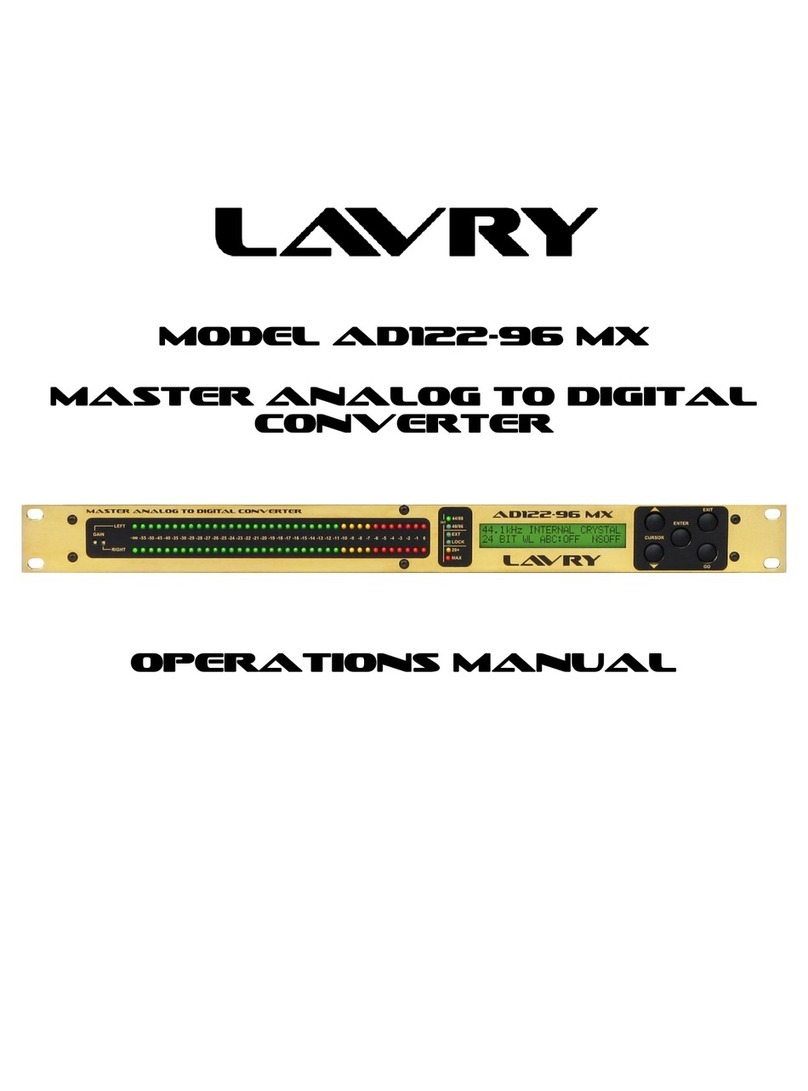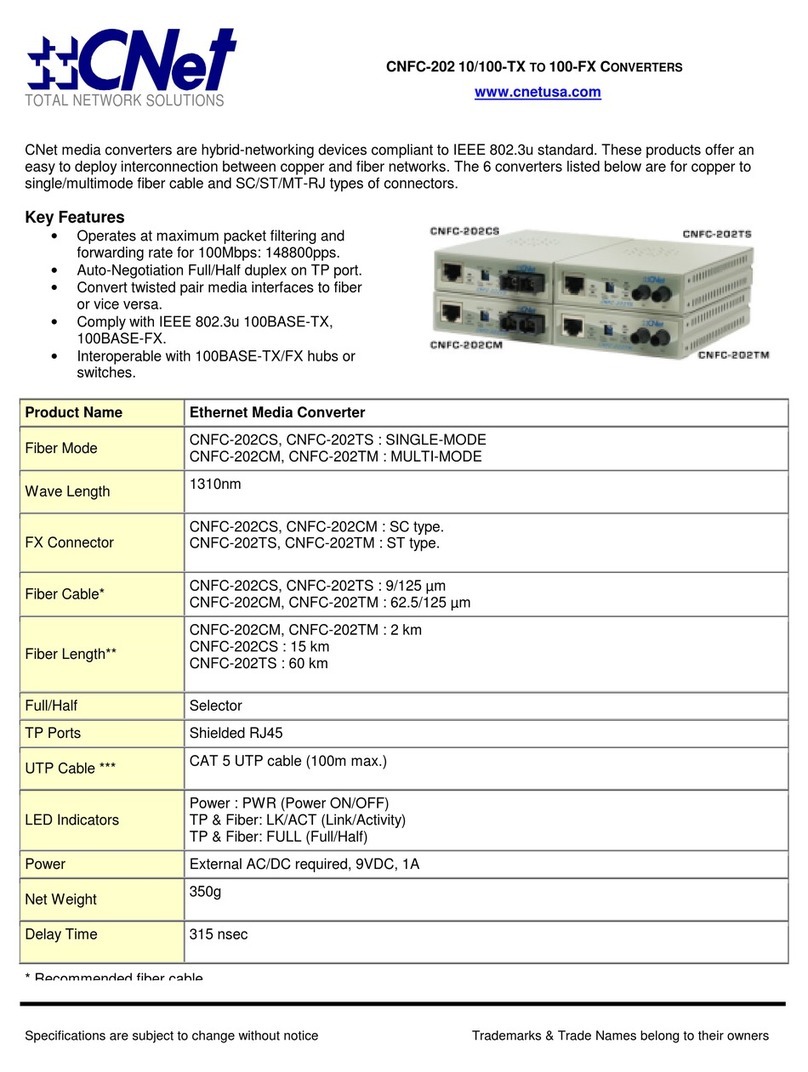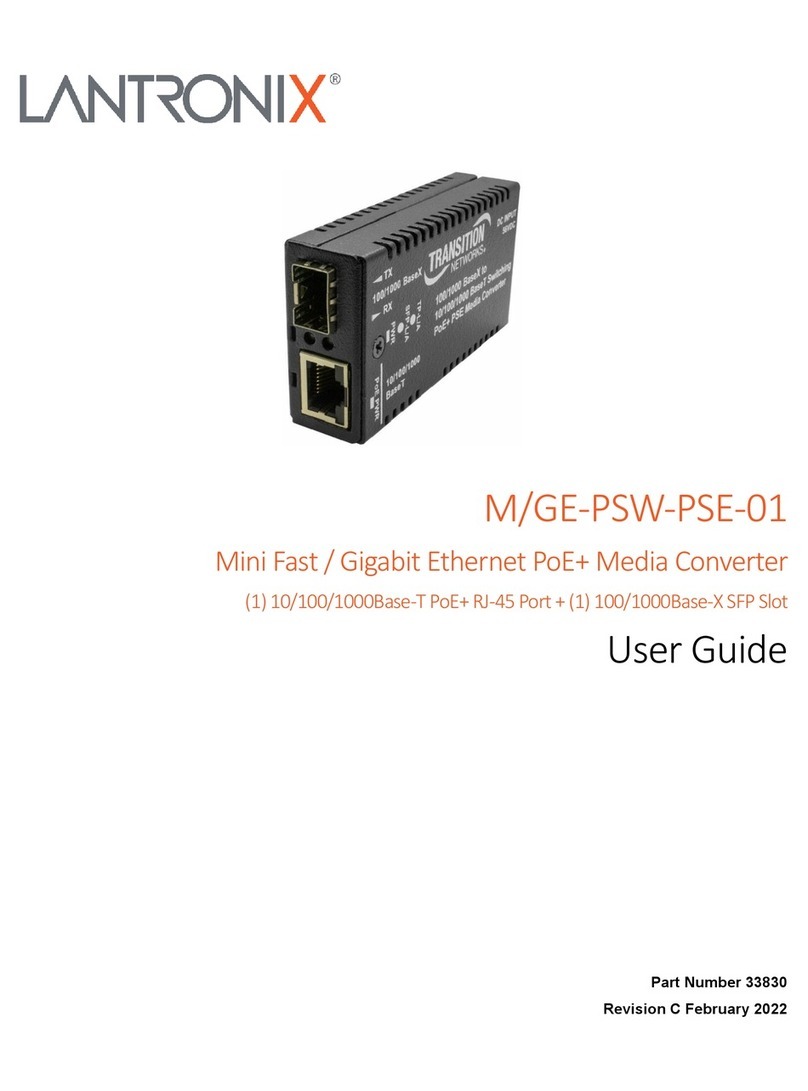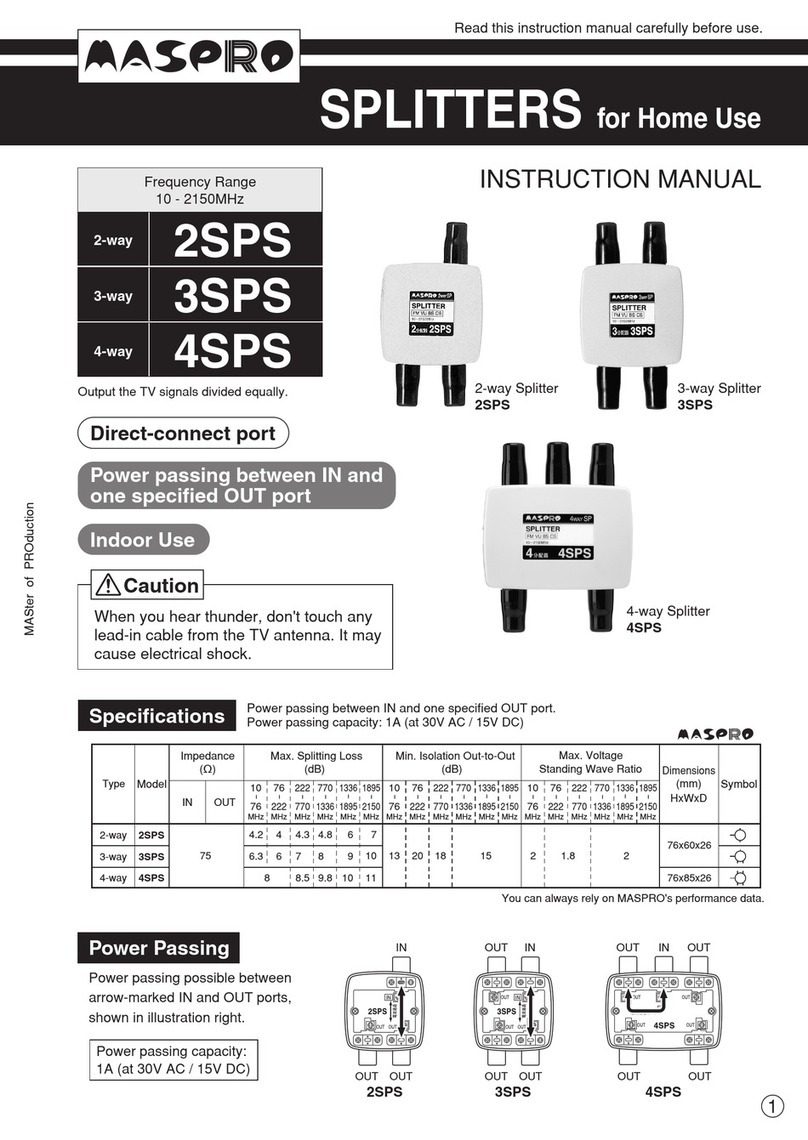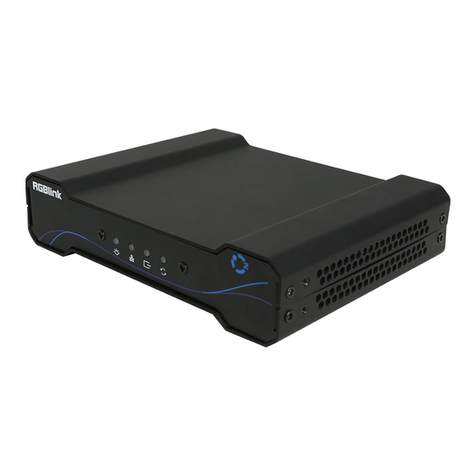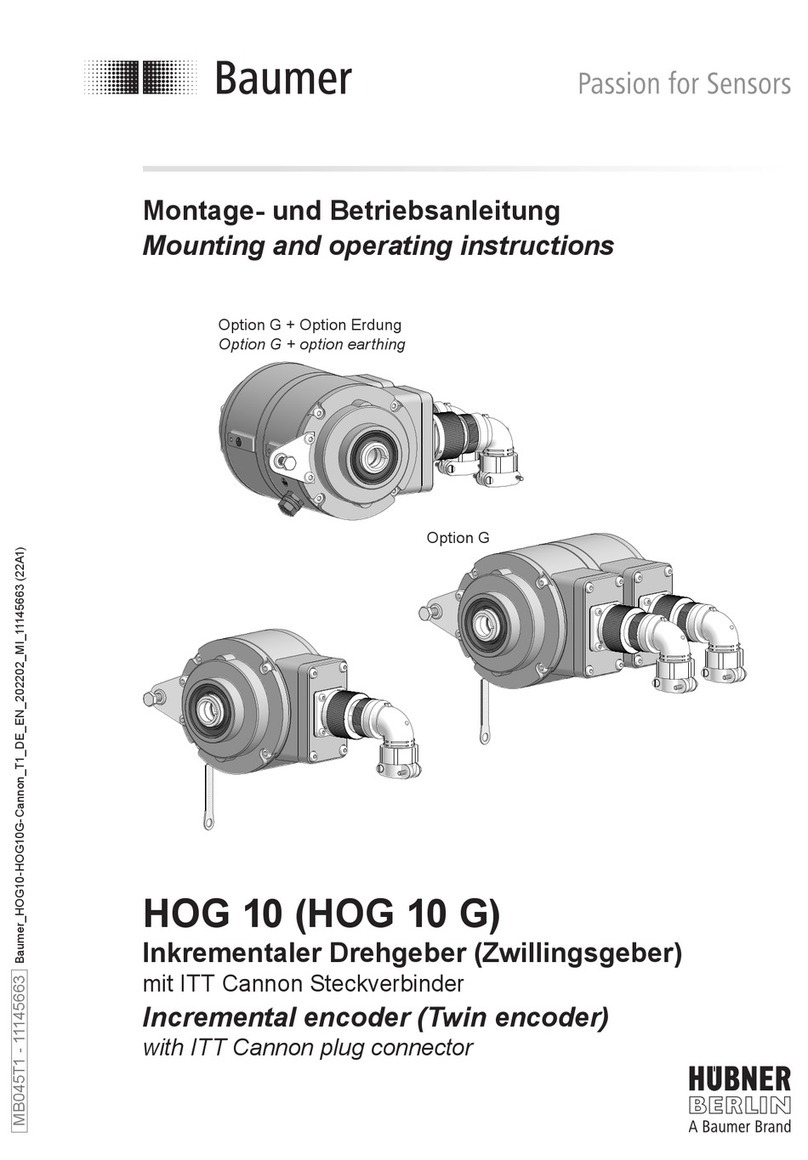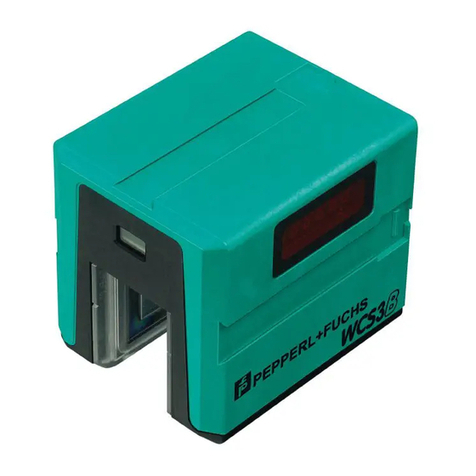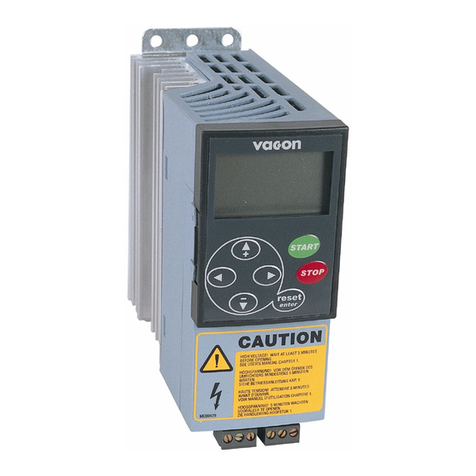Lavry DA924 User manual

Model DA924
High Resolution Digital to Analog Converter
Operations Manual
Lavry Engineering, Inc
824 Post Avenue
Seattle, WA 98104
(206) 381-5891
http://www.lavryengineering.com/
E-Mail: [email protected]
Revision 1.1
March 1998
E
LAVRY
ENGINEERING
I
I

DA924 Operations Manual
2
Copyright ©1998 by Lavry Engineering, Inc. All rights reserved.
Acoustic Bit Correction® and Lavry Engineering® are registered trademarks of Lavry
Engineering, Inc.
CrystalLock™ is a trademark of Lavry Engineering, Inc.
Internet: info@lavryengineering.com
http://www.lavryengineering.com/
LIMITED WARRANTY
Subject to the conditions set forth below, for one year after the original purchase date of the
product, Lavry Engineering will repair the product free of charge in the United States in the event
of a defect in materials or workmanship.
Lavry Engineering may exchange new or rebuilt parts for defective parts. Please call the factory
for an RMA number prior to shipment. No product will be accepted for warranty service without
a pre-issued RMA number.
This warranty is extended only to an original purchaser of the product from Lavry Engineering, or
an authorized reseller of Lavry Engineering. Products that are purchased from unauthorized
resellers do not have any warranty coverage. A valid purchase receipt or other valid proof of
purchase will be required before warranty service is provided. This warranty only covers failures
due to defects in materials or workmanship and does not cover damages which occur in shipment
or failures resulting from accident, misuse, line power surges, mishandling, maintenance,
alterations and modifications of the product, or service by an unauthorized service center or
personnel. Lavry Engineering reserves the right to deny warranty service to products that have
been used in rental, service bureau, or similar businesses.
This limited warranty gives you specific legal rights. You may have others which vary from
state/jurisdiction to state/jurisdiction.
LIMITS AND EXCLUSIONS
LAVRY ENGINEERING DOES NOT, BY VIRTUE OF THIS AGREEMENT, OR BY ANY
COURSE OF PERFORMANCE, COURSE OF DEALING, OR USAGE OF TRADE, MAKE
ANY OTHER WARRANTIES, EXPRESS OR IMPLIED, INCLUDING, WITHOUT
LIMITATION, ANY WARRANTY OF MERCHANTABILITY, FITNESS FOR A
PARTICULAR PURPOSE, TITLE OR NONINFRINGEMENT, AND ALL SUCH
WARRANTIES ARE HEREBY EXPRESSLY DISCLAIMED. LAVRY ENGINEERING
EXPRESSLY DISCLAIMS ANY IMPLIED INDEMNITIES. LAVRY ENGINEERING
SHALL NOT BE LIABLE FOR ANY INDIRECT, INCIDENTAL, CONSEQUENTIAL,
PUNITIVE, SPECIAL OR EXEMPLARY LOSSES OR DAMAGES, INCLUDING, WITHOUT
LIMITATION, DAMAGES TO RECORDINGS, TAPES OR DISKS, DAMAGES FOR LOSS
OF BUSINESS PROFITS, BUSINESS INTERRUPTION, LOSS OF BUSINESS
INFORMATION, LOSS OF GOODWILL, COVER, OR OTHER PECUNIARY LOSS,
ARISING OUT OF OR RELATING TO THE USE OF THE PRODUCT, OR ARISING FROM
BREACH OF WARRANTY OR CONTRACT, NEGLIGENCE, OR ANY OTHER LEGAL
THEORY, EVEN IF LAVRY ENGINEERING HAS BEEN ADVISED OF THE POSSIBILITY
OF SUCH LOSSES OR DAMAGES. ANY DAMAGES THAT LAVRY ENGINEERING IS
REQUIRED TO PAY FOR ANY PURPOSE WHATSOEVER SHALL NOT EXCEED THE
ORIGINAL COST PAID TO LAVRY ENGINEERING FOR THE APPLICABLE PRODUCT.
BECAUSE SOME STATES/JURISDICTIONS DO NOT ALLOW THE EXCLUSION OR
LIMITATION OF LIABILITY FOR CONSEQUENTIAL OR INCIDENTAL DAMAGES, THE
FOREGOING LIMITATION MAY NOT APPLY TO YOU.

Operations Manual DA924
3
Table of Contents
Limited Warranty..................................................................................................2
Introduction............................................................................................................4
PART I
Operating Instructions..........................................................................................5
Input signal selection.............................................................................................5
Input signal connection........................................................................................5
Analog Outputs......................................................................................................6
Analog Output Level Adjustment.....................................................................6
Turn-On sequence.................................................................................................7
Polarity inversion...................................................................................................7
CrystalLock™ and Wide lock............................................................................7
Part II
Theory of operation..............................................................................................9
Oven control...........................................................................................................9
Calibration...............................................................................................................9
Timing and deglitcher...........................................................................................10
Jitter removal..........................................................................................................11
Output filter and drivers......................................................................................11
Power and Fusing.................................................................................................11
Maintenance............................................................................................................12
Part III
Specifications..........................................................................................................13

DA924 Operations Manual
4
Introduction
The DA924 converts incoming digital inputs to 24 bit analog audio signals. The
combination of excellent linearity, small quantization steps, fast and accurate response and
low noise performance enables reproduction of the finest details. The DA924
accommodates today's standard sample rates (40-50KHz) and the higher rates of the new
standards (80-100KHz).
The DA924 provides many enhancements to the classical resistor weighting architecture. A
triple segmented design improves the accuracy of the 10 most significant bits. Short term
accuracy is maintained by keeping the critical components at constant temperature in a
linearly controlled oven. Long term accuracy is achieved by extensive use of continuous
automatic self-calibration.
A large number of extra codes enable the addition of digital DC offset to the signal path
without signal clipping. The DC offset provides superior low level detail by keeping low
level signals away from the most significant bit transitions. A quad switch deglitcher
circuit removes the unwanted transition glitch energy.
The DA924 eliminates jitter in the incoming data stream by use of a DSP controlled
pullable crystal oscillator and a short buffer memory for temporary storage of the incoming
data. The DSP transfers the data from the memory to the DAC disregarding any jitter in the
input frequency. A proprietary fast-lock high-accuracy measurement compares the average
input frequency to the oscillator frequency and makes the appropriate adjustments. The
adjustments are done with sub pico-second resolution, to insure minimum interference with
signal reconstruction.
Additional features:
• 96kHz, 88.2kHz, 48kHz and 44.1kHz conversion frequencies
• Multi-bit architecture with 24 bits, non Sigma-Delta
• Very low Total Harmonic Distortion + Noise
• Automatic calibration
• Increased low level accuracy
• CrystalLock™ Digital Jitter removal
• Professional and consumer inputs and outputs
• Supports New Hi-density I/O Standards from Sonic Solutions

Operations Manual DA924
5
PART I: Ope ra ting Ins tr uc tion s
Operation of the Model DA924 Digital to Analog Converter requires the use of two
push button switches located on the front panel.
POLARITY inverts the absolute polarity of the signal.
INPUT SELECT controls selection of digital inputs to the DAC.
Input signal selection
The INPUT SELECT lamp indicators show the selected input signal. Pressing the
INPUT SELECT push button moves to the next input position.
Holding the INPUT SELECT button for more then a second makes the DA924 go into
search mode: the unit will step through the inputs but will skip the inactive input connectors
(where no signal is present).
Holding the INPUT SELECT button for more than one second switches between manual
input selection and the input search mode, or visa versa. The mode selected is retained
when power is removed.
Input signal connection
The unit can be connected to one, two or three digital input connectors located on the rear
panel:
AES/EBU input to the XLR connector designated as AES INPUT 1
AES/EBU input to the XLR connector designated as AES INPUT 2
SPDIF (consumer format) input to IEC INPUT.

DA924 Operations Manual
6
Analog Outputs
The LEFT OUTPUT and RIGHT OUTPUT XLR signals are factory set to provide
Balanced analog signals (signal between pin 2 and pin 3 of the XLR connectors).
Operation in unbalanced mode (signal at pin 2 and ground at pin 3) is possible by changing
the internal jumpers J8 and J10 located behind the XLR analog output connectors inside the
case.
The factory default setting is for Balanced outputs-- the jumpers are positioned parallel to
the front panel.
For Unbalanced mode position the jumpers are set to 90 degrees with respect to the front
panel.
Pin 1 of the XLR connectors is connected to ground potential for proper cable shield
connection.
The LEFT OUTPUT and RIGHT OUTPUT IEC signals are always unbalanced and
are not effected by J8 and J10 jumper settings.
Analog Output Level Adjustment
Level control trim pots are located between the LEFT OUTPUT and RIGHT OUTPUT
XLR connectors. When hooked for balanced output, the full scale analog level can be
adjusted between 12dBu to 22dBu.
When hooked for Unbalanced output, the full scale analog level can be adjusted between
6dBu to 16dBu.
The IEC connector level is adjustable between 8dBu and -8dBu full scale signal.
The wide 0-10dB attenuation range relies on an internal pot. When operating at minimum
attenuation (22dBu balanced or 16dBu unbalanced), the signal is tapped directly from the
top of the pot thus the pot is effectively out of the signal path. Increasing the attenuation
introduces more and more pot resistance into the signal path.
While taking all precautions to minimize sonic degradation associated with use of pots in
the signal path, we offer alternative factory settings, trading off the adjustment range from
21dB to 2.8dB (+/-1.46dB). These settings minimize the impact of the pot on sonic
quality, and may be of interest for users willing to have the unit set for operation with a
very low range of level adjustment. Contact the factory for more information.
Turn-On sequence
When applying AC power to the unit, the following sequence of events take place:

Operations Manual DA924
7
1. The unit goes into mute mode.
2. Warm-up: An internal oven heats up the temperature-sensitive devices to a set
temperature. The warm-up time depends on the initial temperature and may take up to 5
minutes for a cold unit. During warm-up, the unit blinks the two upper status lamps (44.1
and 48 light emitting diodes).
3. When set temperature is reached, the unit goes into self calibration mode. The calibration
time may take a few minutes. During calibration, the unit blinks the two lower status lamps
(88.2 and 96 light emitting diodes).
4. The unit finds the first active input and converts digital audio to analog sound.
The DA924 figures out the incoming sample rate for the selected input and displays the
incoming frequency (44.1, 48, 88.2 or 96KHz). When all inputs are inactive, the unit
steps through the input ports continuously as indicated by the input select lamps if in auto
select mode.
Most DACs contains relays for the purpose of muting the output during turn on (allowing
the DAC to settle to proper operating conditions). The DA924 contains no relays, in order
to avoid signal degradation associated with relay contacts. The unit deals with the turn on
spike by incorporating very slow tracking power supplies for its output stage, thus
disabling the drive capability during turn on. The DA924 turn on spike may be higher then
that found in other DACs but the sound is not compromised. The spike due to power off is
comparable to that found in other DACs.
Polarity inversion
The normal polarity is set to pin 3 hot. To invert, press the POLARITY switch. Signal
inversion is indicated by a lit INVERT lamp.
Inverting while in unbalanced operation impacts signal polarity on the IEC center
conductor.
Inverting while in unbalanced operation impacts signal polarity on pin 2 of the XLR
connector.
Inverting while in balanced operation swaps pin 2 and pin 3 of the XLR connector.
CrystalLock™ and Wide lock
The DA924 eliminates jitter in the incoming data stream by use CrystalLock™, a DSP
controlled pullable crystal oscillator and a short buffer memory for temporary storage of the
incoming data. The DSP transfers the data from the memory to the DAC disregarding any
jitter in the input frequency. A proprietary fast-lock high-accuracy measurement compares
the average input frequency to the oscillator frequency and makes the appropriate
adjustments. The adjustments are done with sub pico-second resolution, to insure
minimum interference with signal reconstruction.
CrystalLock™ meets and exceeds the AES lock range requirements ( +/- 100ppm). Such
narrow lock allows the use of pullable crystal oscillators, thus yielding the best
performance from a jitter standpoint. The DA924 provides a wide lock mode for tracking
sample rates between 40 and 50KHz, and 86 and 98kHz. Clock jitter levels increase when

DA924 Operations Manual
8
using varispeed, thus its use should be restricted for sample rates outside of the narrow
lock range. Some multi-channel uses of the DA924 may require varispeed for
synchronization.
To enable wide lock, press and hold the POLARITY button for 1.5 seconds. To return to
CrystalLock™, press and hold the POLARITY button again. The unit indicates
varispeed mode by blinking the appropriate status light periodically. This mode setting is
retained when power is removed.

Operations Manual DA924
9
Part II: T he o r y of ope r a t ion
The simplified block diagram (figure 1), shows the basic building blocks.
Oven control
The PCM DAC is constructed of custom made laser trimmed thin film resistor networks;
yet any resistor is subject to short term drift due to temperature variations and long term
drift due to component aging. The resistor networks are kept at a constant temperature by a
linearly controlled heating element. (A bang-bang controller, such as a home thermostat is
undesirable because it produces turn on and turn off surges-- thus audible kicks.) Keeping
the resistors at constant temperature overcomes resistor dependency on environmental
temperature variations.
Figure 1
Calibration
A sequence where each resistor is tapped (one at a time) for voltage comparison against a
reference level tells the processor the required adjustments. The voltage difference between
any given network node and the reference is greatly amplified and then fed to a strobing
comparator (see multiplexers for calibration and error amplifier and comparator gain blocks
in the simplified diagram). The processor strobes the comparator and reads its output. The
strobing is repeated 4000 times for the sake of averaging out any error due to amplifier
noise. At the end of a comparator strobing cycle, the processor decides whether to increase
or decrease the specific voltage of the measured node. This is done via the calibration 14 bit
DACs (see diagram). Each calibration DAC is used as a 13 bit device to ensure monotonic
performance. Each DAC is fed to its corresponding node through a large value resistor,
thus a full 10V swing on the calibration DAC can only pull a given node by +/-4mV,
providing an effective adjustment of a part in 5 million per calibration DAC step.
The calibration process takes a long time because the node adjustment is interactive
(adjusting a node causes some misadjustment at all the other nodes). A single calibration

DA924 Operations Manual
10
cycle consists of reading and adjusting of all the nodes. The processor repeats the
calibration cycle numerous times until all the nodes are set properly. Though nodes
interaction exist during the adjustment process, the overall network is guaranteed to
converge on a solution by design. Calibrating a DA924 for the first time (at the factory)
often exceeds 25 minutes. Once calibrated, the settings are stored in non volatile ram for
future startup point of reference, thus all future adjustments are initialized to the last
settings. Therefore the initial tolerance of the components is pre calibrated already, and each
new calibration needs to deal only with component drift under the same given temperature
conditions (ovenized components). The remaining calibration at each subsequent power on
takes less then 2 minutes typically.
Timing and deglitcher
The conversion from a digital sample value to an analog voltage consists of translating a
digital code to a corresponding setting of analog switches and multiplexers to tap the
appropriate voltage from the analog nodes. Such switching causes unwanted glitch energy
to come into play. The glitch energy is code and signal dependent and can not be removed
by filtering. The purpose of the deglitcher circuit (see diagram) is to block the signal from
feeding to the output for long enough time after each transition, thus allowing the glitches
enough time to disappear, and for each new analog sample to accurately settle to its final
value.
The deglitcher circuit is in off state about half a sample time, and on for the rest of the time.
The on time, is the critical time and no digital activity takes place anywhere near the analog
circuits. The settled signals are fed to the output filter with minimum disturbance. The
deglitcher off time settling requires the circuit to block as much of the transitions from
feeding forwards to the output filter.
The blocking requirement is very demanding because a transition of many volts between
two adjacent sample values should feed forward less than a micro volt. A single switch can
not yield such blocking performance. The deglitcher utilizes four switches: the first switch
shunt (shorts) the signal to ground. The remaining signal is connected to the second switch
that is in open state. Whatever comes through gets shunted to ground be the third switch.
The remaining tiny energy is further blocked by the fourth opened series switch.
During the deglitcher on state, the shunt switches (switch one and three) are opened and the
series switches (switch two and four) are shorted to allow the signal path to the output. The
deglither circuit utilizes DMOS technology thus providing extremely low resistance during
the on state. The remaining problems due to on state resistance variations is neutralized by
use of the strong feedback of the deglitcher amplifier.
The main reason for using DMOS transistors is their sub nanosecond switching
capabilities. The jitter critical timing point is all at the deglitcher circuit. Each sample value
must exist over the same time period thus precise deglitcher turn on and turn off are critical
for good results. In fact switching during deglitcher blocking time can be somewhat
sloppy, as long as the signals are well settled prior to turn on. Fighting the jitter wars
means feeding the deglitcher circuit a precise jitter free on / off drive signal.
Jitter removal
Ordinary phase lock loops circuits (PLLs) do a reasonable job at removing high frequency
jitter from the incoming clock. The same circuits perform very poorly in the removal of low

Operations Manual DA924
11
frequency jitter from the clock signal. The need to keep enough bandwidth for locking to
and tracking the incoming data translates to zero rejection of low frequency jitter content
(typically hundreds of Hz of zero rejection bandwidth). While some of the jitter content is
random, much is due to coupling of the data itself into the receiver circuitry.
The DA924 uses a non standard approach for removing jitter. The deglitcher circuit is
clocked by a pullable crystal oscillator but the control signal for the crystal is freed from
having to track down incoming clock variations. The clock oscillator is controlled by a
processor driven DAC (not an ordinary phase detector plus filter circuit). The oscillator
frequency is change by tiny amounts (.1ppm) and not very often (15 seconds or more) in a
manner allowing it to track only very long term average drift. Using such an approach with
ordinary PLL will cause loss of lock because the slight variations in incoming data rate
cause loss of correspondence between the input and the too steady of a clock circuit. The
DA924 CrystalLock (TM) approach, stores enough data in a dedicated memory to
guarantee that each clock cycle can find its data. Moving the clock slowly to track the long
term average drift is done just fast enough to make sure that the buffer memory does not
overfill or becomes empty.
At first glance one may get concerned about the potential long delay due to storage of a lot
of data samples. In fact, the data storage is very small and so is the delay. An "unrealistic"
100ppm per second input rate step requires pre storage of about 5 words of data for 1
second D/A stepping, or an 50 word memory for 10 seconds of D/A update rate.
Output filter and drivers
The DA924 operates in low oversampling to allow for maximum settling time of the DAC
circuits and to further reduce sensitivity to jitter. The upsampling filter is calculated by the
DSP. The tradeoff in favor of low oversampling operation pauses an increased requirement
for analog anti imaging filtering. The DA924 incorporates a seven pole analog filter.
The transistor based output drivers are short circuit protected and are capable of driving
balanced 300 Ohm loads. As always, for best results it is recommended to use high quality
cables. When running a cable through an electrically noisy environment, a termination
impedance of 600 Ohms (at the destination, not at the DA924 side) may prove useful .
Power and Fusing
The Model DA924 operates at 50 or 60 Hz, and has two line voltage selections, 115 volts
and 220 volts, switchable on the back panel. 115 volts operation requires a 1/2 ampere 250
volt fast blow fuse; 220 volt operation requires 1/4 ampere 250 volt fast blow fuse. Both
American and European size fuses can be accomodated. Two fuses are required.
Operation up to 240 volts is possible with no change in performance using the 220 volt
setting. Optimal operation requires 115 volts AC.
Maintenance
The Model DA924 is an auto calibrating converter requiring no periodic adjustments. The
unit's reliance on linear power supplies and discrete class A analog circuitry generates a
significant amount of heat (25 watts maximum). The temperature rise is no cause for
concern, but allowing for some air flow is always a benefit from a long term reliability
stand point.

DA924 Operations Manual
12
The front panel is gold plated (24 karat gold). Use a soft cloth (and plain water, if
necessary) to clean finger prints.

Operations Manual DA924
13
Part III: Spec ifica tions
Noise -110dBFS rms, 130dBFS peak spurious response
Distortion 1kHz tone at -1dBFS: .0009%FS peak harmonic amplitude
1kHz tone at -60dBFS: .00009%FS peak harmonic amplitude
10kHz tone at -1dBFS: .0009%FS peak harmonic amplitude
10kHz tone at -60dBFS: .00009%FS peak harmonic amplitude
Sample rate 96kHx, 88.1kHz, 48kHz, 44.1kHz at +/- 150ppm lock range
40-50kHz wide lock mode (varispeed)
Crystal lock™ tracking 1ppm / 15 seconds
Channel separation -100dBFs at 1KHz
Flatness response +/- .05dB (10Hz -20KHz)
Phase linearity 2 degrees (10Hz - 20 KHz)
Digital inputs two AES/EBU, 110 Ohm, transformer isolated
one Consumer, 75 Ohm, transformer isolated
Analog outputs AES/EBU balanced 22dBuFS into 600 ohms Max
12dBuFS Min
AES/EBU unbalanced 16dBuFS into 600 ohms Max
6dBuFS Min
Consumer outputs 8.5dBuFS into 10k ohms Max
-2.5dBuFS Min
Warm-up and initial calibration 10 minutes maximum
Hardware 19 inch rack mount, 1U high
115V 60Hz or 220V 50Hz, 20 Watts
Options Removable interface for future I/O hardware interface
Table of contents
Other Lavry Media Converter manuals

Lavry
Lavry M AD-824 User manual
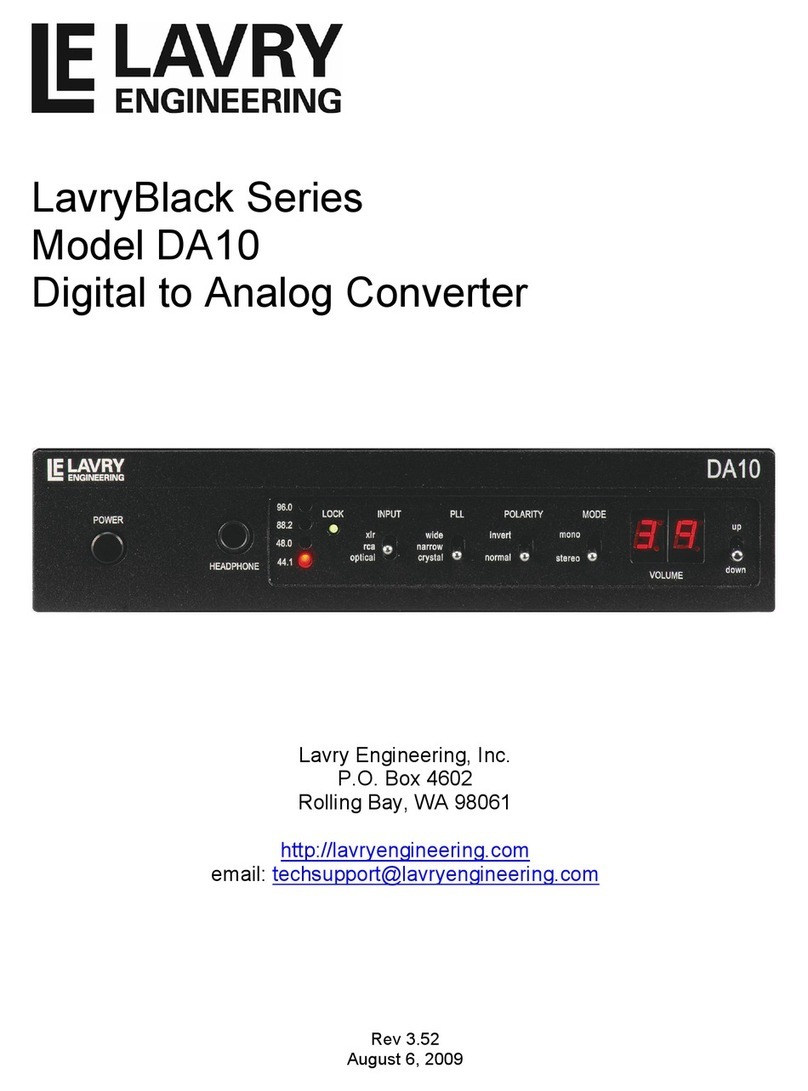
Lavry
Lavry DA10 User manual

Lavry
Lavry M AD-824 User manual

Lavry
Lavry DA10 User manual

Lavry
Lavry LavryBlack Series User manual

Lavry
Lavry DA2002 User manual
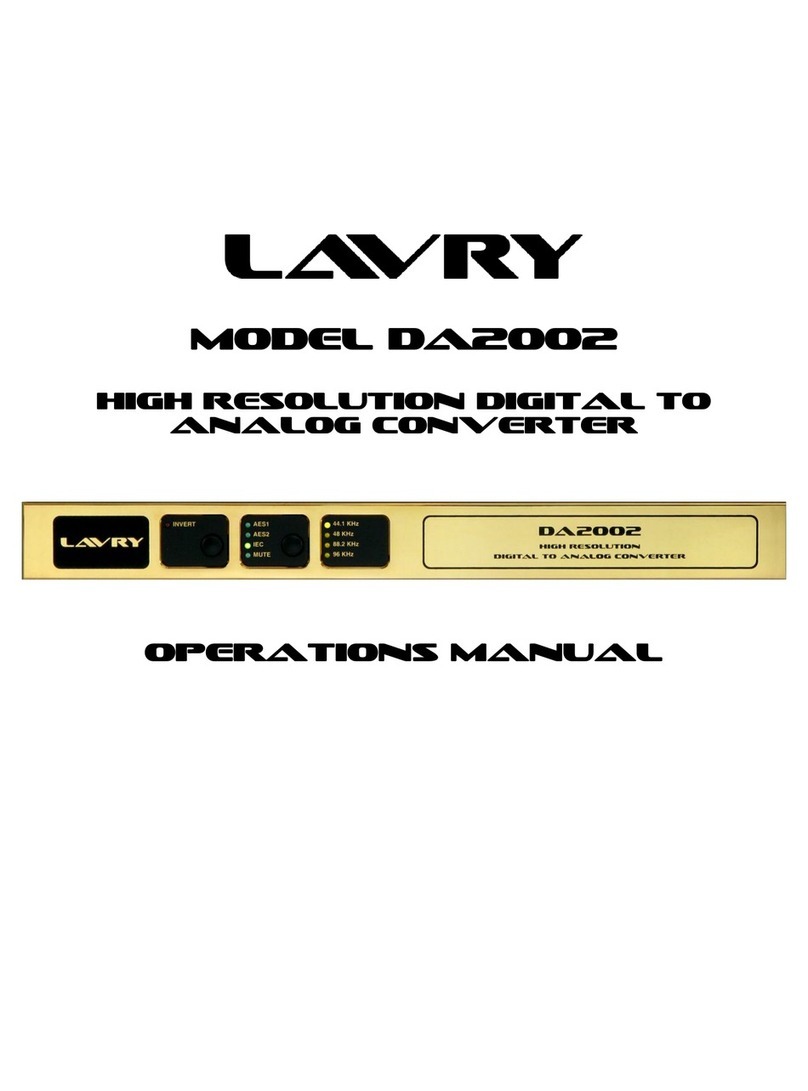
Lavry
Lavry DA2002 User manual
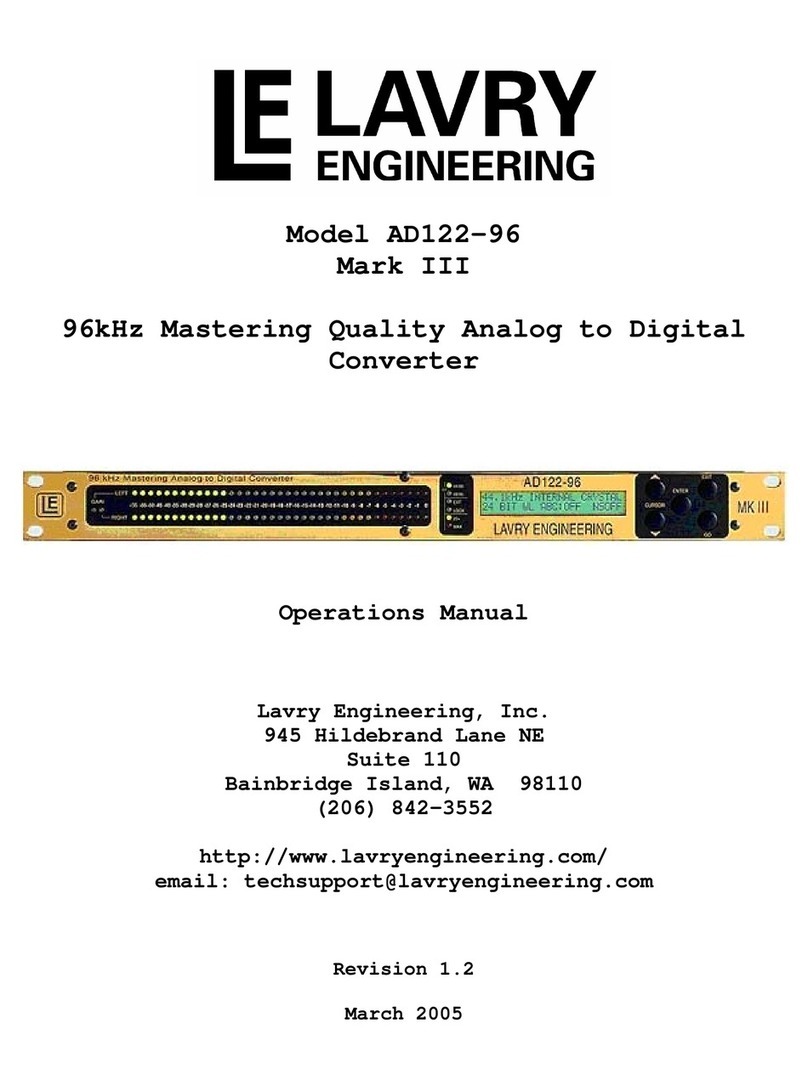
Lavry
Lavry AD122-96 Mark III User manual

Lavry
Lavry AD11 User manual
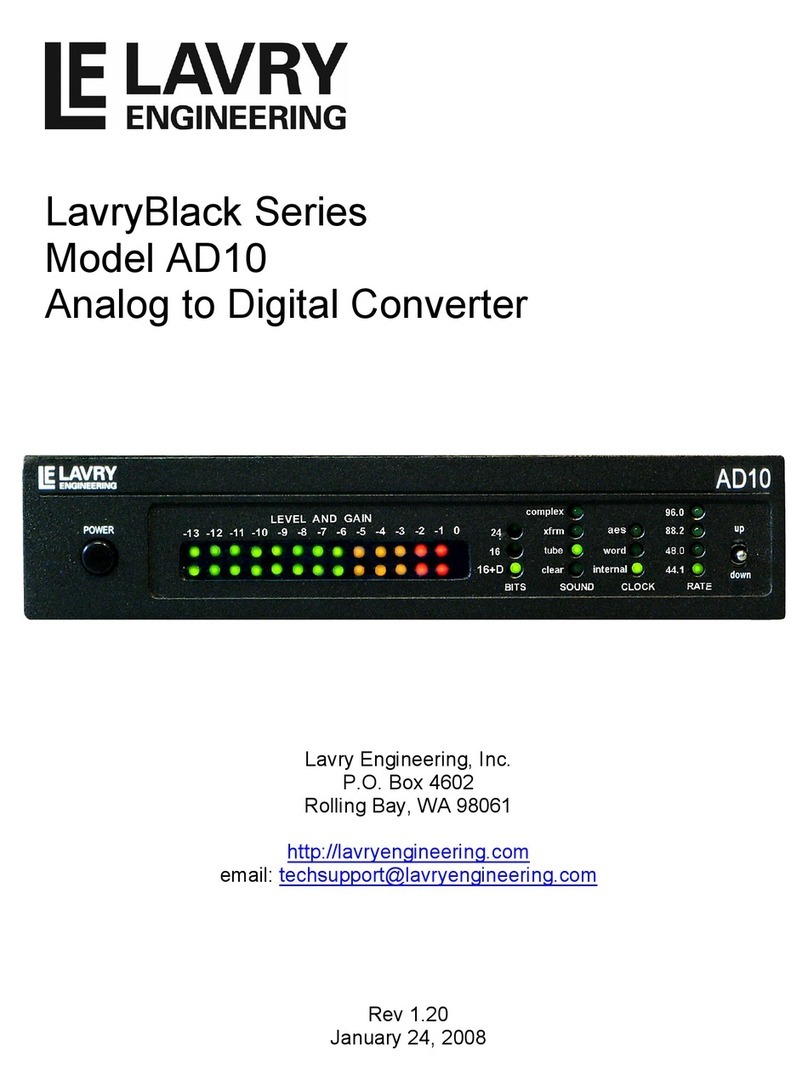
Lavry
Lavry LavryBlack Series User manual

